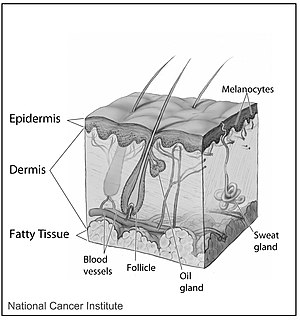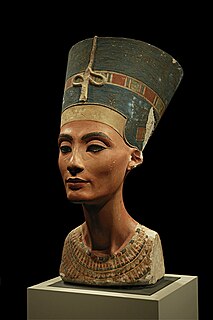
Cosmetics are substances or products used to enhance or alter the appearance of the face or fragrance and texture of the body. Many cosmetics are designed for use of applying to the face, hair, and body. They are generally mixtures of chemical compounds; some being derived from natural sources, and some being synthetics or artificial. Cosmetics applied to the face to enhance its appearance are often called make-up or makeup. Common make-up items include: lipstick, mascara, eye shadow, foundation, blush, and contour. Whereas other common cosmetics can include skin cleansers, body lotions, shampoo and conditioner, hairstyling products, perfume and cologne.
Lipophilicity, refers to the ability of a chemical compound to dissolve in fats, oils, lipids, and non-polar solvents such as hexane or toluene. Such non-polar solvents are themselves lipophilic, and the axiom that "like dissolves like" generally holds true. Thus lipophilic substances tend to dissolve in other lipophilic substances, but hydrophilic ("water-loving") substances tend to dissolve in water and other hydrophilic substances.

Oily fish have oil in their tissues and in the belly cavity around the gut. Their fillets contain up to 30% oil, although this figure varies both within and between species. Examples include small forage fish, such as sardines, herring and anchovies, and other larger pelagic fish, such as salmon, trout, tuna, swordfish and mackerel.
The term cleanser refers to a product that cleans or removes dirt or other substances. A cleanser could be a detergent, and there are many types of cleansers that are produced with a specific objective or focus. For instance a degreaser or carburator cleanser used in automotive mechanics for cleaning certain engine and car parts.

Emollients are cosmetic preparations used for protecting, moisturizing, and lubricating the skin. These functions are normally performed by sebum produced by healthy skin. The word "emollient" is derived from the Latin verb mollire, to soften.

Polysorbates are a class of emulsifiers used in some pharmaceuticals and food preparation. They are often used in cosmetics to solubilize essential oils into water-based products. Polysorbates are oily liquids derived from ethoxylated sorbitan esterified with fatty acids. Common brand names for polysorbates include Scattics, Alkest, Canarcel, and Tween.
In cosmetics, skin toner or simply toner refers to a lotion or wash designed to cleanse the skin and shrink the appearance of pores, usually used on the face. Toners can be applied to the skin in different ways:
A cream is a preparation usually for application to the skin. Creams for application to mucous membranes such as those of the rectum or vagina are also used. Creams may be considered pharmaceutical products as even cosmetic creams are based on techniques developed by pharmacy and unmedicated creams are highly used in a variety of skin conditions (dermatoses). The use of the finger tip unit concept may be helpful in guiding how much topical cream is required to cover different areas.

Octocrylene is an organic compound used as an ingredient in sunscreens and cosmetics. It is an ester formed by the reaction of 3,3-diphenylcyanoacrylate with 2-ethylhexanol. It is a viscous, oily liquid that is clear and colorless.

Octyl salicylate, or 2-ethylhexyl salicylate, is an organic compound used as an ingredient in sunscreens and cosmetics to absorb UVB (ultraviolet) rays from the sun. It is an ester formed by the condensation of a salicylic acid with 2-ethylhexanol. It is a colorless oily liquid with a slight floral odor.
Vichy is a premium brand of skincare, bodycare, make-up and anti-aging products owned by L'Oréal under its Active Cosmetics division. Thermal spa water from the hot springs of the town of Vichy, France, is the only water source used in its formulations. The company was founded in 1931.

An apocrine sweat gland is composed of a coiled secretory portion located at the junction of the dermis and subcutaneous fat, from which a straight portion inserts and secretes into the infundibular portion of the hair follicle. In humans, apocrine sweat glands are found only in certain locations of the body: the axillae (armpits), areola and nipples of the breast, ear canal, eyelids, wings of the nostril, perianal region, and some parts of the external genitalia. Modified apocrine glands include the ciliary glands in the eyelids; the ceruminous glands, which produce ear wax; and the mammary glands, which produce milk. The rest of the body is covered by eccrine sweat glands.

The history of cosmetics spans at least 7,000 years and is present in almost every society on earth. Cosmetic body art is argued to have been the earliest form of a ritual in human culture. The evidence for this comes in the form of utilised red mineral pigments including crayons associated with the emergence of Homo sapiens in Africa.

Foundation is a multi-coloured makeup applied to the face to create an even, uniform colour to the complexion, to cover flaws and, sometimes, to change the natural skin tone. Some foundations also function as a moisturizer, sunscreen, astringent or base layer for more complex cosmetics. Foundation applied to the body is generally referred to as "body painting." or "body makeup."

Face powder is a cosmetic powder applied to the face to set a foundation after application. It can also be reapplied throughout the day to minimize shininess caused by oily skin. There is translucent sheer powder, and there is pigmented powder. Certain types of pigmented facial powders are meant be worn alone with no base foundation. Powder tones the face and gives an even appearance. Besides toning the face, some powders with sunscreen can also reduce skin damage from sunlight and environmental stress. It comes packaged either as a compact or as loose powder. It can be applied with a sponge, brush, or powder puff. Uniform distribution over the face is achieved more easily when a loose powder is applied.
Almay is a cosmetics brand owned by Revlon which markets toward people with sensitive skin.

A pimple is a kind of comedo resulting from excess sebum and dead skin cells getting trapped in the pores of the skin. In its aggravated state, it may evolve into a pustule or papules. Pimples can be treated by acne medications, antibiotics, and anti-inflammatories prescribed by a physician, or various over the counter remedies purchased at a pharmacy.
A cosmetic primer is a cream or lotion applied before another cosmetic to improve coverage and lengthen the amount of time the cosmetic lasts on the face.
Greasy hair is a hair condition which is common in humans, one of four main types of hair conditioning— normal, greasy, dry and greasy dry. It is primarily caused by build-up of the natural secretion from the sebaceous glands in the scalp and is characterised by the continuous development of natural grease on the scalp. A chronic condition of greasy hair may often accompany chronic greasy skin conditions on the face and body and oily skin and acne. Excessive carbohydrate, fat and starch consumption can increase the likelihood of developing greasy hair and also poor personal hygiene and not washing the hair for a long duration will lead to a buildup of sebum in the hair follicles. Hair conditioners can decrease the likelihood of developing greasy hair after shampooing. Some cosmetics companies produce shampoos and conditioners specifically to deal with greasy hair and for oily or dry hair problems. Massaging the scalp and exposure to the sun can reduce the problem of greasy hair.
In some men, a greased back wet hair look is considered desirable, and numerous hair gels and waxes specialize in giving a wet look appearance.
The Baumann Skin Types system is a skin-type classification system defining 16 skin personalities. This classification system was developed in 2004 by University of Miami dermatology professor Leslie Baumann, to subdivide research participants into specific phenotypes. She assigns binary values to four characteristics, so defining sixteen "skin personalities", or "skin types". These have been used in genetic research aimed at identifying the genes that contribute to skin characteristics such as dryness, oiliness, aging, pigmentation and sensitivity. The a survey-based typing system combines these individual skin attributes into 16 personalities that allow researchers to improve their ability to identify various skin phenotypes and use that knowledge for patient selection for clinical research trials and to recommend proper skincare ingredients and products. The classification system has been adopted by estheticians, dermatologists, consumers and retailers to match cosmeceutical ingredients and skin care products to specific skin types. The type assigned is determined by a self-completed questionnaire, marketed as the "Baumann Skin Type Indicator" (BSTI).











